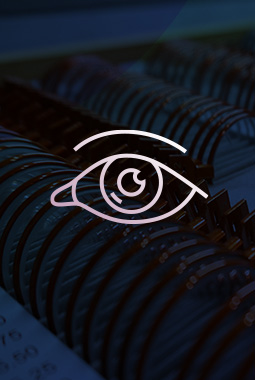Screen-Based Eye Strain
What does your technology do for you? Today, we can order dinner, buy concert tickets, chat with friends, play games, and even work, all from any device with a screen. Smartphones, gaming consoles, computers, and tablets make our lives more convenient.
But, there are some drawbacks to increased screen time. It’s almost impossible to get away from devices at school, work, or home, and as a result, many Canadians experience discomfort related to digital eye strain. Too much screen time can also affect how kids’ eyes develop, linking to an increased risk of myopia (nearsightedness).
Digital eye strain, also known as computer vision syndrome, refers to a group of ocular issues stemming from too much time spent using digital devices.
If you’re experiencing eye discomfort after staring at your screen, we can help. We’ll assess your screen habits and provide some strategies to mitigate your discomfort.
Book an appointment to find relief from digital eye strain today.
Book Appointment OnlineSymptoms of Digital Eye Strain
There are a few common symptoms associated with digital eye strain, including:
- Dry eyes
- Headaches
- Eye strain
- Blurry vision
- Neck and shoulder pain
Often, symptoms will alleviate when you take a screen break. But, discomfort will return once you’re in front of a digital device again. To find relief in the long term, you’ll need to implement some mitigation strategies.
It’s also important to visit your optometrist to help detect any other conditions that might affect your eye comfort.
Mitigation Strategies
Adjusting your work area, taking intentional screen breaks, and ensuring you have sufficient lighting while using your digital device are all strategies that can help reduce digital eye strain.
Ergonomics
Office (or classroom) ergonomics and proper posture can help you stay comfortable while using digital devices. While you’re at your desk, be sure to sit upright with your feet flat on the floor. Your shoulders should not be rounded or hunched, and your neck should align with your torso.
Keep devices at eye level and your keyboard and mouse near enough to prevent reaching.
Remind kids to keep their backs lined up with their chairs, or imagine keeping their backs straight as a tree.
Settings
If you’re reading on your digital device, increase the font size to minimize squinting. Contrast and colour tones should also be set to maximize your comfort.
Talk to your child about what font size feels most comfortable for them and help them make appropriate contrast adjustments.
Lighting Levels
The light levels around you and on your device can help prevent digital eye strain. Turn down your screen’s brightness to match the lighting levels of your surroundings. If the light from the room is reflected in your screen, the glare can also contribute to eye strain.
Anti-glare screens are available for your device’s display, and glasses with an anti-reflective coating can help.
Remind your kids to turn on the lights in dark rooms to avoid tired eyes.
The 20-20-20 Rule
When you’re concentrating on your work, it might be challenging to take a break, but following the 20-20-20 rule can help relax your eyes. Every 20 minutes, look at something 20 feet away for 20 seconds. This helps give your eyes refocus, reducing strain.
Set a reminder on your phone or set up parental controls on your kid’s device for scheduled breaks and screen time limits.
Kids & Digital Eye Strain
Adults use screens frequently, but they’re creeping into kids' lives too. Studies show that the risk of children developing visual issues increases after 2–4 hours of screen time.
The Canadian Association of Optometrists recommends that children avoid screen time 1 hour before bedtime and never bring a screen into their bedrooms. Breaks should be encouraged frequently when kids are using screens, particularly outdoor breaks, for whole-body physical activity.
Children should have regular, comprehensive eye exams to support the health of their vision, regardless of their screen time. Schedule an appointment to support your child’s eye health today.
Book Appointment OnlineOur Location
Visit Us
Find us on the corner of Main Street and Beaver Lake Road. We are accepting new patients and looking forward to welcoming you and your family.
Our Address
- 49-9522 Main Street
- Lake Country, BC V4V 2L9
Contact Information
- Phone: 250-766-4240
- Fax: 250-766-4267
- Email: [email protected]
Our Hours
- Monday: 9:00 AM – 5:00 PM
- Tuesday: 9:00 AM – 5:00 PM
- Wednesday: 8:00 AM – 7:00 PM
- Thursday: 9:00 AM – 5:00 PM
- Friday: 9:00 AM – 5:00 PM
- Saturday: 9:00 AM – 3:00 PM
- Sunday: Closed
Our Brands





Frequently Asked Questions
Can you make glasses with an external prescription?
Yes, we accept all prescriptions for glasses that have not expired. If your prescription is expired or you need to have your prescription assessed, we are more than happy to book you an appointment with one of our doctors for an exam.
How long does it take for glasses to arrive?
We make glasses in-house, and it takes around 3 hours for us to edge the lenses into your frame of choice. If glasses need to be ordered in, they typically take around 7 to 10 business days. Specialty orders may take longer to arrive. Our optical will do our best to give you an accurate time estimate and have your glasses made as soon as we can.
What is included in a full eye exam?
A full eye exam includes the following:
-
- A comprehensive ocular and medical history check-up to identify or assess your risk factors for certain eye diseases
-
- A vision check and prescription for glasses, if warranted
-
- Binocular vision testing to check how your eyes are functioning together
-
- A measurement of intraocular pressure (IOP) on all patients
-
- An optomap scan of your retina on all patients
-
- An OCT (optical coherence tomography) scan for adults
-
- A comprehensive eye health check in the office by the doctor
-
- If warranted, your eye doctor may recommend a visual field test to better assess peripheral vision in association with the use of medications with risk of harmful effects on vision
What is the cost of an eye exam?
Children (18 and under), seniors (65+), or those with certain medical conditions are eligible for medical services plan (MSP) coverage. MSP covers part of the eye exam and visual field tests (think of it like insurance), lowering the total cost of the exam you/your insurance is responsible for. We do not charge for children age 2 and under.
A patient is NOT eligible for MSP coverage if:
- You are from out of province
- Not registered with BC medical
- If you have had an eye exam elsewhere within the past year
| Service | Full Cost | If MSP Billable |
| Adult Eye Exam (19+) | $162 | $115 |
| Adult Contact Lens Wearer Eye Exam (19+) | $177 | $130 |
| Child Eye Exam (2-18) | $85 | $30 |
| Child Contact Lens Wearer Eye Exam (2-18) | $100 | $45 |
Do you do LASIK co-management?
Yes, we are more than happy to be a part of your LASIK journey. We are pleased to offer post-op follow-ups.
Can you direct bill my insurance?
Yes, we can directly bill most insurance companies. If your insurance company is not eligible for direct billing, we will provide you with a detailed receipt to submit for reimbursement.
What do I need to bring to my eye exam?
Please bring a list of medications, your glasses and contact lenses (or your last prescription), and any forms that need to be completed.
How long is an eye exam?
Full eye exams are usually between 30 to 45 minutes.
Do I have to be dilated during the exam?
Our office offers wide-field retinal imaging with the optomap machine on all patients who are physically able to. The optomap scan provides a 200-degree image of the retina (inside lining of the eye).
In certain cases, dilation is still recommended to better assess the retina and check for cataracts and other ocular diseases. If you are dilated, we encourage bringing a driver with you so you feel more safe on the way home.





